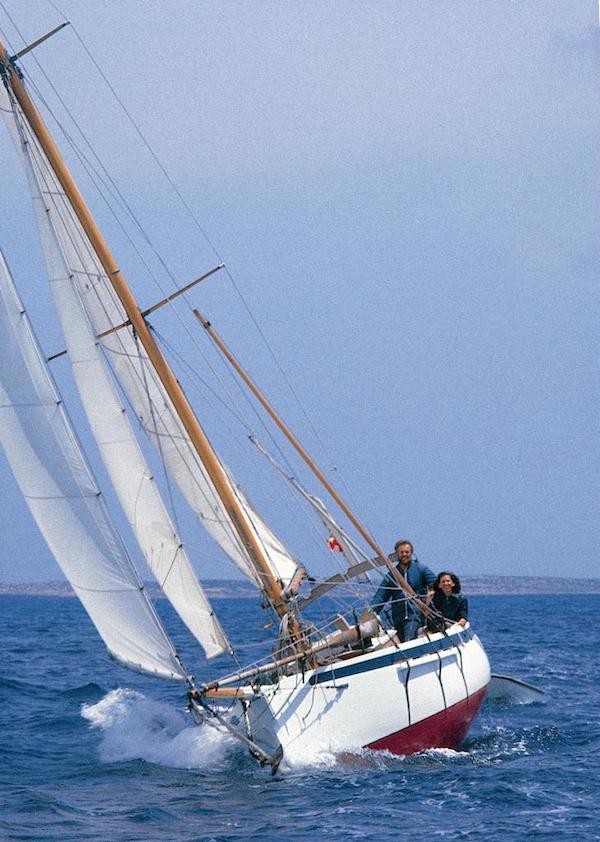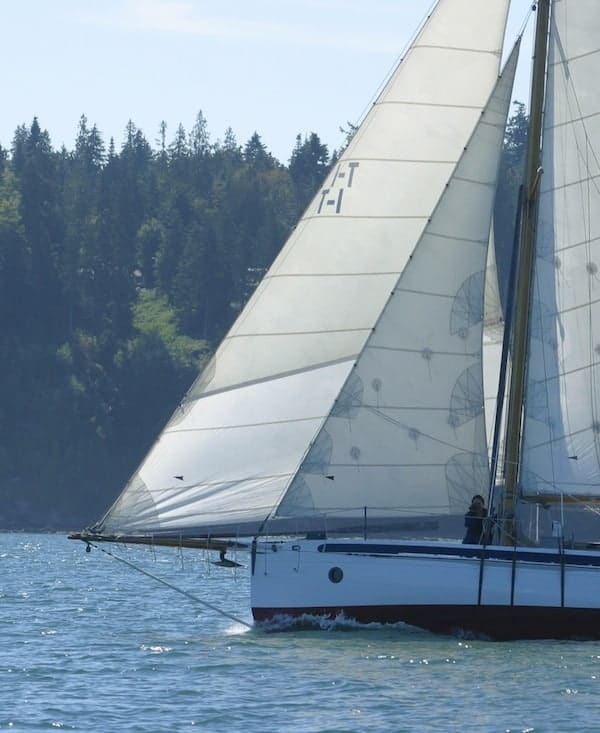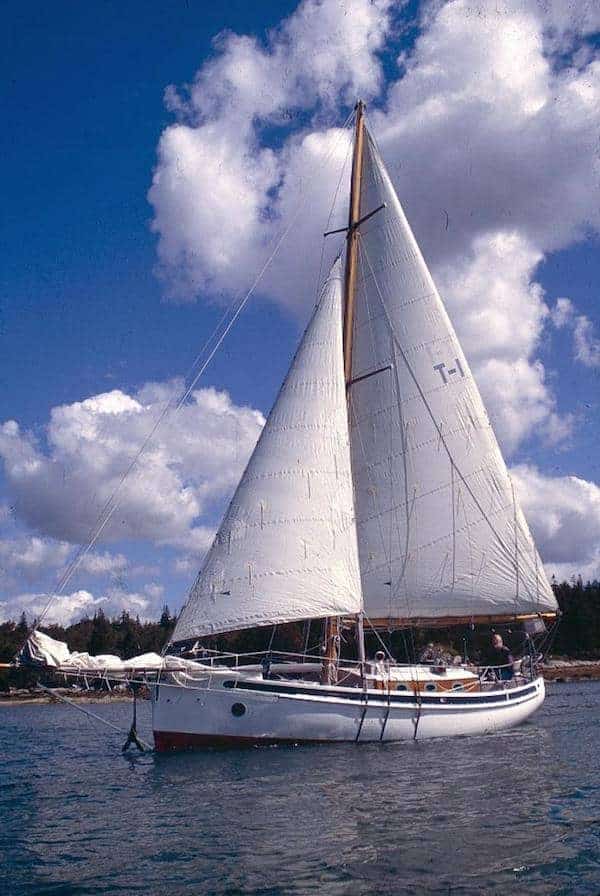Email This Page to a FriendOur Favorite Sailing Rig: The Cutter, by Lin and Larry Pardey
January 15, 2015
For any sailing boat under 45 feet, nothing beats a properly-designed cutter rig, especially if you sail shorthanded. By properly designed I mean, having a staysail that is large enough to be used as the only headsail in winds above 20 knots. Thus, if your boat has a bowsprit, you can bring the jib in as soon as the sea begins to build, and continue sailing with a rig that’s all inboard—one that balances nicely when the mainsail has a reef or two in it. Your staysail should also be of sufficient size and far enough forward so you can tack in tight confines using only staysail and mainsail, even in relatively light winds. This makes it very easy to maneuver up to moorings or into marina berths because, when you’re finished with it, you can more easily douse a staysail than the big jib of a sloop.
Larry and I wrote a complete chapter in our book, Capable Cruiser about the advantages of the cutter rig and tips that can make the staysail your favorite sail. Last year we updated the information and have included it below.
The following is excerpted and adapted from chapter 9 of Lin and Larry Pardey’s book Capable Cruiser.
Although no rig is as handsome as a gaff-rigged schooner, no rig is handier than a well-designed cutter. It gives you better performance to windward than a two-masted rig. You have less rigging to buy, and only one mast, one mast step, and one boom to build. A windvane for self-steering can be installed more easily on a cutter than on a ketch, yawl, or schooner, because the cutter’s boom usually doesn’t overhang the transom. The three smaller sails of a cutter are easier to handle and reef than the two larger sails on a sloop—all things being equal. Most important of all, the cutter rig gives you the most versatile sail to be found on a cruising boat: the staysail.
But to get the full potential from this special sail requires careful attention to details. The staysail on our cutter TALEISIN is heavily constructed of 8-ounce U.S. Dacron. It has two rows of reefs, and is set on a movable stay. This gives us a sail that can be used in a wide variety of wind conditions, from Force 2 all the way to storm Force 10. Alone on watch, it’s easy to keep the boat moving well by using a combination of the mainsail and the big jib, with the staysail set in between. The staysail can be simply dropped if the wind increases, or, conversely, we can hoist the staysail when the breeze drops.
This easy increase of sail area improves our average passage times. Compare this with a single-headsail sloop rig. One headsail has to be taken off and another hauled up on deck and set up in its place whenever you want to change the sail area. Needless to say, everyone has to reduce sail area as the wind increases; but when we’re sailing on a boat with a single-headsail rig, we usually find ourselves putting off sail increases—especially when alone on watch at night. This reluctance to change up can easily cut 10 or 20 miles off a day’s run. Your staysail gives you flexibility. If you are reaching at top speed with the full rig as you come into the lee of the land, and you find you have to short-tack into an anchorage, the cutter gives you two quick and easy sail-change choices. You can drop either the staysail or the jib and tack easily into the bay. In gusty williwaw conditions—like those often found in the lee of steep headlands—or to work through narrow channels, we usually choose to drop the jib and use the staysail and main. But if we find we need more power once we get inside the anchorage, the jib is lying in the jib net, ready to go back up.
But it is in strong winds that the staysail really pays its keep. When you use your staysail with a reefed-down mainsail, it reduces your sail plan proportionately, so it becomes a smaller triangle with about the same fore-and-aft balance, or lead, as that that of the full rig. Compare this with a deeply-reefed, single-headsail sloop where the reefed sail area moves forward, usually causing a lee helm. A boat with lee helm has difficulty holding her bow up to the wind and seas, and therefore is a poor windward performer.
About 90 percent of our sailing on TALEISIN is done with three sails: the 7-ounce, 100 percent bonneted jib; the 8-ounce staysail with two rows of reefs; and the 8-ounce mainsail with three rows of reefs. (This gives us about the same total sail area that a sloop would have with a 135 percent genoa and a mainsail.) We depend greatly on our staysail. Unreefed, it can be a heavy-weather staysail; reefed once, it’s a storm staysail; and in a hard flog to windward, it works double-reefed as a spitfire staysail that is set with the triple-reefed main or, in extremely heavy conditions, in combination with our trysail. This may seem like a lot of reefs to some sailors. But we were once down to triple-reefed mainsail and single-reefed staysail on our old boat SERAFFYN as we reached into Malta on a storm-force northwesterly wind. I was thinking to myself, “Damn, I could use a trysail and another reef in the staysail just in case the wind increases, or I am headed and have to beat into Marsaxlokk Harbor.”
The main reason our staysail is loose-footed, with no club or boom, is that it allows us to conveniently release the staysail stay and move it aft when we have to short-tack using the jib. Clearing away the staysail stay allows the jib to pass across the foredeck without hanging up on the staysail stay. This means that one person can tack the boat easily in light winds, freeing the other person to navigate and watch for coral heads or rocks. Another advantage of our boomless staysail is that it can overlap the mast a bit. This gives you a little more sail area and an increase in slot efficiency compared to the shorter-footed boomed staysail.
If you eliminate the club on your staysail, you will save the expense of a sheet tackle, a traveler, a gooseneck, and the spar itself. It will also keep your foredeck clearer and thus make it easier to change sails and work the anchor windlass and ground tackle.
The day sailor or coastal cruising sailor usually is in love with his or her self-tending staysail. It allows one to tack in and out of creeks, rivers, and narrow inlets with only the jibsheets to handle. But the boomless staysail works better for the open-water cruiser for whom short-tacking is not the norm. Our solution to the occasional short-tacking we have to do is, as mentioned above, to use one headsail at a time. We release the Hyfield lever holding the staysail stay, and bring that stay (with the sail still attached) back next to the mast to make tacking the jib easier. It is safe to sail with the staysail stay released until the wind breezes up and the mast begins to bend. Then it should be set up again. This is especially true if you are rail down and punching into a head sea.
The question now is: If we had a sloop that met all our other cruising needs, would we go to the trouble and expense of converting it to a double-headsail (cutter) rig? I most definitely would add a staysail with a release lever if it met the following requirements: (a) It had a masthead rig which would allow for a long luff on both staysail and jib; (b) it had a generous distance between jibstay and mast that was at least as long as the main boom; (c) it had sufficient beam for the staysail to breathe easily in the open slot between mainsail and jib; and (d) the staysail could be designed so that it was at least 22 percent of the total working sail plan (i.e. mainsail, working jib, and staysail). Otherwise, it would not have sufficient drive to be used alone with the mainsail. With these parameters, a staysail could be added, and the resulting extra sail area forward might even reduce that common fault: a weather helm.
The addition of the staysail stay would require a tang and halyard connection aloft, along with two intermediate supporting shrouds led to chainplates aft of the mast. On larger, more powerful boats (35 feet and over), running backstays would be required. The connection at the lower end of the staysail stay should attach securely to the stemhead on a boat with a bowsprit. Or, if the stay is attached to the middle of the foredeck, a rod or wire below decks should tension the stay to either a bulkhead or the forefoot. Add to this some deck fairleads and you’ve got quite a hardware bill, not to mention the cost of labor. But I think it is worthwhile if the boat you now own can gain the subtle but important advantages of a staysail.
The staysail is the most versatile sail on our cutter, so it is subjected to a lot of wear and tear. We tend to watch it more closely than any other sail onboard, since it is the sail on which we will depend in extreme conditions. If you are intent on sailing offshore, I would suggest that once you notice signs of wear, have a spare staysail made, check to be sure it fits, and then stow it below so that you have two strong sails in reserve.
Here is a link where you can purchase Lin and Larry Pardey’s book Capable Cruiser.
5 Responses So Far to “Our Favorite Sailing Rig: The Cutter, by Lin and Larry Pardey”:





The racing version McGregor 65 had essentially the same set-up – cutter staysail on a removable (albeit hydraulic) cutter stay. It really increased the sail options available and was great for singlehanding with main and stay sail. Had a great sail alone one day with staysail and full 900 sq ft main at 17 knots for 5 hours. Also when crewed and running with a learning crew you could sail wing on wing with jib and stay sail poled out and main if too narly for 2400 sq ft spinnaker. I LOVE that rig.
I realize that this is an older article but still an excellent one. Thank-you, very much and I do agree with your conclusions, on the cutter rig. My first wooden boat was a double head sail sloop (1927 Eldridge-McGinnis design) effectively making it a cutter with a self tending staysail w/boom and running back-stays. A very versatile rig, indeed!
Love the cutter rig. Love the Staysail. Good article. Thanks
While, like so many others who have followed your tales and stories over the many, many years. This article explaining the benefits of cutter rigs, is as usual right on the button. I am as you may realise, a new subscriber. though, I have bought your disk and books and used them in while building now rebuilding mary t, a Hartly 21f 6Trailer sailer with a fixed ballast keel. She has been a nice little sea boat. Thanks for all the imfo they has given me. I shall be on the water again quite soon now.
Way, way, way more than just a favorite rig here! Thanks Lin & Larry for another excellent share.